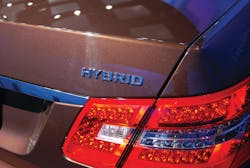SUBJECT: Hybrid & Electric Vehicle Identification
TOPIC: Society of Automotive Engineers (SAE) J2990 Document
OBJECTIVE: Understand the requirements of the newly published Society of Automotive Engineers (SAE) J2990 document
TASK: The rescue team shall review the SAE J2990 document and determine how the requirements of this Standard will positively impact responder safety and rescue operations at incidents involving a hybrid or electric plug-in vehicle.
It was a simple email from the Society of Automotive Engineers (SAE). The message was short and sweet. “This notification is to inform you that document: J2990_201211 – Hybrid and EV First and Second Responder Recommended Practice has been published.” Sweet isn’t an adequate word to describe the significance of this one-sentence message. These words represent the culmination of a multi-year effort and quietly announce a major victory for fire, rescue, medical and law enforcement responders. The SAE International organization produces guidelines and recommended practices that automakers follow as they design their vehicles. Much of what we find present today in a vehicle is a result of an SAE Standard.
SAE Standards include almost 10,000 documents created through consensus standards development by more than 240 SAE Technical Committees with 450+ subcommittees and task groups. The SAE has officially published document J2990 that will, from this point forward, serve as a guide and recommended practice for auto manufacturers to follow regarding hybrid and electric vehicles. The J2990 document truly focuses on many critical aspects of hybrid and electric vehicles from a responder’s point of view. This author served on the J2990 SAE committee as a representative of the fire service, spending over a year’s worth of volunteer effort to help make this document become a reality.
The Standard includes many significant requirements. The Emergency Response Guides (ERG) that exist for every hybrid and electric vehicle will begin to be standardized. In addition, they will have to include a two-page ERG quick-reference guide sheet that will actually be functional enough that it could be used at an incident scene.
Exterior markings
An extremely significant portion of J2990 standardizes the exterior markings, called “badging”, currently used by manufacturers to advertise that their vehicle is a hybrid or electric vehicle. Up until the publication of this Standard, there was no requirement for exterior badging on a hybrid or electric vehicle; three General Motors (GM) hybrids have no exterior hybrid badging at all. From this point forward, to comply with the new Standard, manufacturers now have two choices for badging. The preferred method requires a minimum of three exterior badges to clearly identify the vehicle as a hybrid or electric plug-in. One must be on the rear of the vehicle while the others can be along each side of the vehicle.
The second hybrid and electric vehicle identification option allows the manufacturer to only place one exterior badge on the rear of the vehicle. If this option is chosen by the manufacturer, responders will find that the new requirements call for something that we do not currently have: a required interior hybrid or electric vehicle marker. What we will see in the coming years will be a durable emblem or insignia securely affixed at an interior location that is visible when looking through the driver or passenger window while outside the vehicle. The marker will be near the key ignition switch or the start/power button on the instrument panel, console or steering column. This interior marker will be designed to be as readily identifiable both when the vehicle is powered ON as when the vehicle is powered OFF.
Vehicle Shut-down
Other significant items addressed in the new J2990 Standard require manufacturers to design their vehicles with a minimum of two out of a possible four methods to shut down the high-voltage (HV) electrical system. Automatic shutdown of the high-voltage system is the primary and preferred HV shutdown method from a responder perspective as it means that upon significant impact, the HV electrical system automatically shuts down even before we get the call.
A second HV shutdown primary disabling method that also complies with J2990 shuts down the HV system when a responder turns off the ignition at the key or power/stop button. A third, optional design that is acceptable allows the cutting or disconnecting the cables of the 12-volt electrical system to also shut down the high-voltage system as well. In this case, responder “cut labels” also have to be provided to indicate which cables need to be cut or disconnected to accomplish shutdown.
The fourth method of HV electrical system shutdown for a hybrid or electric vehicle involves designing the manual disconnect device to be accessible and designed for use by responder personnel without any special or unique electrical protective gear. These disconnects will all be orange in color to standardize their identification at crash scenes.
It would be well worth fire service agencies obtaining a copy of this new Standard from the SAE and studying its contents. This is a major victory for the fire service; one that we need to understand better before we can realize how significantly this document will improve our safety and increase our efficiency at a hybrid or electric plug-in vehicle incident.
TASK: The rescue team shall review the SAE J2990 document and determine how the requirements of this Standard will impact responder safety and rescue operations at incidents involving a hybrid or electric plug-in vehicle.
Read Part 2 here.






